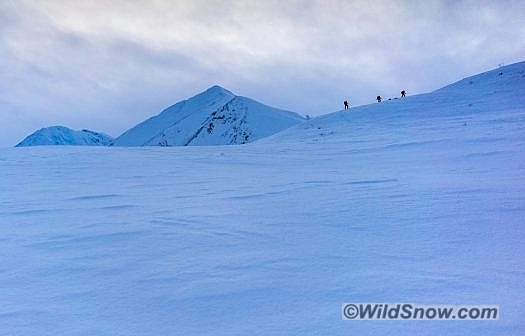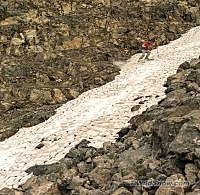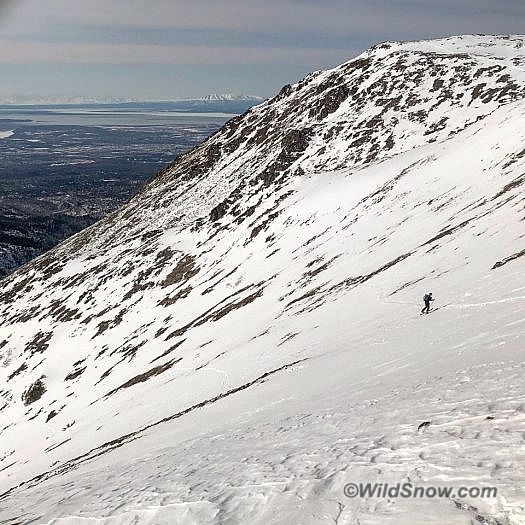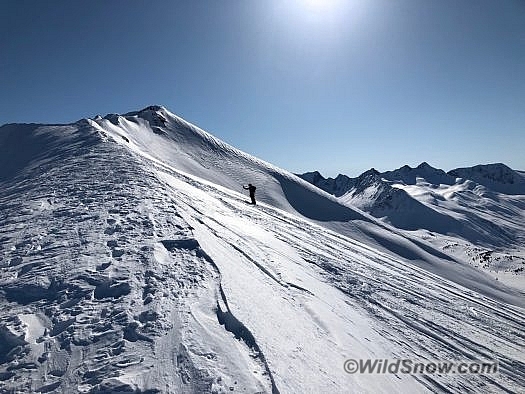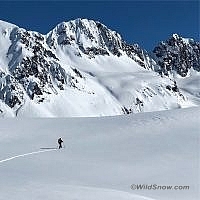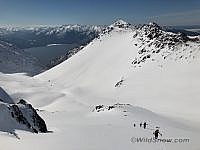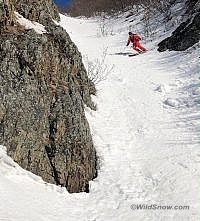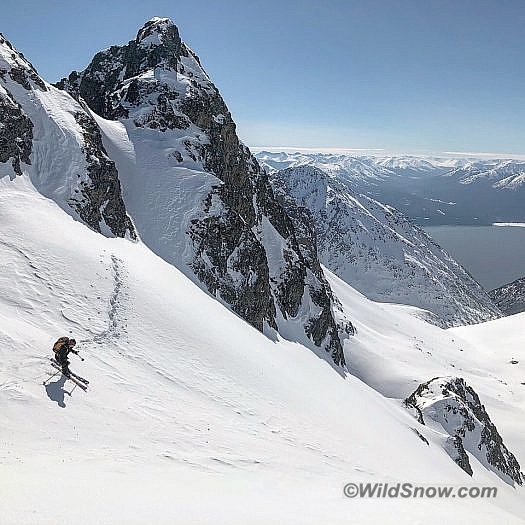Alex Lee
“We only need to find 10 turns for it to count!” said Andy, as we marched into the Alaskan mountains near Anchorage, in search of late summer snow.
Last Wednesday I met up with a couple friends at the Glenn Alps parking. We headed off for the evening on a last ditch effort to ski last year’s goods. We biked into the Chugach towards a small wiggle of frozen water still clinging to its north facing refuge. Blueberries, and the remnant light of the boreal summer, guided our way to a slick grass scramble and unstable talus wallow.
Andy was carrying a pair of homemade snow-blades with tech ski-touring bindings. He calls his setup “the future.” (“It sure ain’t the past,” was my initial reaction, reminiscing on the 1990s heyday of snow-blades, which tore about the resort but I never saw utilized as a ski mountaineering tool…).
We each got exactly ten turns, and biked out at sunset. The final vestige of summer.
The nights are starting to cool off, and I think our 10-turns outing probably marks the end of my 2017/2018 season. So before looking ahead to the 2018/2019 winter, a few reflections on my first full year in Alaska: lessons of patience, persistence, maritime snowpacks, long days, and darkness.I moved to Alaska a year and a half ago from Colorado for a job teaching at a university in Anchorage, and for a dream of snow, mountains, and subarctic adventure. The north provides all of these, wonderfully.
The Alaskan ski calendar cleaves into two seasons – optimism and pessimism. Below, a few lessons I took from both.
Pessimism: Low expectations emerge in August as the last bit of the snow retreats to the glaciers of Alaska’s remnant Pleistocene. Termination dust creeps down the mountains by September, and by the end of October the bears head to sleep – a welcome relief from pepper spray and predator checks. Ice climbing and rock skis seem like good ideas and hot chocolate returns as an old friend.
Lesson One – Don’t Expect to Be Told Where to Go
My season began last year, chasing access to the high country in the Western Chugach. Asking around for information about skiing the glaciers near Girdwood, early snow on Hatcher’s Pass, or the first chutes to fill in near Anchorage felt like trying to buy street drugs (or so I’d imagine) – most people scowled and said no such skiing existed, a few people dodged the question, and one or two would pass on the goods in back alleyways with hushed voices and vows of secrecy.
The Jewel Glacier offers an early season hotspot that lots of southcentral AK folks head to in the fall before avalanche danger stymies the approach. Once I had been there, people kept saying, “Yea, that place is great.” But before I had been there, people kept saying, “What’s that?” No doubt some locals fear I have just given away too much….
Lesson Two – Always Bring A Colossal Puffy
The fall soon gives way to winter and I learned that November into early February is a time for beards, mittens, and whiskey. The days are short, the snowpack still shallow, and the winds cold (like really cold). Pessimism sets in. One resigns to discomfort, laziness, headlamps in every pocket, and low expectations.
Skiing before 10 am starts to sound crazy (it’s dark), and the Coloradoan in me began shouting, “I thought it was warm by the ocean!” and “Why are we going outside when it’s dark and stormy?” To which Alaska promptly responded, “Because its fun, you softy!”
Despite low expectations, the simple joy of a few good turns makes any day a success.
I fell in love with Turnagain Pass during this past winter. In my opinion, it’s the gem of the greater Anchorage area (I know Hatcher Pass loyalists will scoff…). Long tours in low light to endless terrain made Turnagain’s magic truly shine. Early in the year, the snow was sketchy, but the Pass is a bit more maritime than anything closer to Anchorage or north of town (like Hatcher). A search for safe terrain amongst the spines that adorn much of the area also yields decent results. While Tincan and other popular spots do have lower angle, more protected options. I was thrilled to find access to such a wonderland of ski touring – no matter the angle of the day (I also admit that I fell further in love with Turnagain once the steeps were a reasonable goal).
Optimism: An odd thing happens from mid February through March – the sun returns. Days normalize, the snow deepens, stoke grows. This is not spring — still too cold and snowy — but now optimism begins to fill the air. Talk of mountains and big days supplants the existential reflection of the dark times.
Lesson Three – Patience
Last year the snowpack never mellowed out for long in terms of avalanche danger. As with nearly any backcountry ski region in the world, if you wait out the dangerous times, you can get plenty of safe days.
I promised an easy outing to a few friends. After two perfect pow laps on the Fin, we pointed across the valley. I’m not sure how many hours later, but what seemed like a mile of skinning turned into a near vertical alder climb up to a 50 degree boot pack through waist deep snow. My two dogs were with us, I hadn’t brought lunch, my wife went from unimpressed with my route choice to downright pissed at me (good thing it was my birthday). We got back just before dark.
While the day had moments of misadventure (and a dose of sub-optimal decision-making on my part), it also marked an attitude of optimism bounded by respect for the mountains. They’re big. If you let your guard down avalanches, snow caves, and frostbite are on deck. Over beers back in town, we agreed, “…we just got Alaska-ed!” (..though Margi was probably also thinking: “I just got Alexed!” Why are spouses always right?).
The optimism of late winter creates a buzz of creativity. I capitalized on this with a few random trips to explore other parts of the state. The interior, cold and windy, is beautiful and quiet in the winter. Valdez is rainy and fickle, but amazing: Thompson Pass has the most incredible roadside terrain I’ve ever seen (5000ft lines are real!). The front range of the Chugach holds plenty of good skiing for those willing to look.
Spring showed up seemingly overnight sometime in April. Big lines to sea level, sneakers, bear spray, and peaks made the transition obvious. By then, optimism shone across Alaska. Things look so good in the spring that hibernating mammals wake up even before the food they rely on turns green.Lesson Four – Alders Are Evil
Alders are obnoxious any time, but in spring their true evil is unveiled. As they melt out they form a formidable defense to the retreating snow. Sometime in late March I headed out towards an unnamed couloir that drains into the Turnagain Arm just south of town. While shwacking through the alders, a branch somehow snaked into my ear. It didn’t hurt, but I immediately lost all hearing on that side. I tried to play it cool with my ski buddy, but was feeling dizzy and uncoordinated. We skied anyway – maybe not the best call, but it was fun. Turns out I perforated my eardrum (it healed in about a month). Hey, it’s Alaska, you’re just as likely to lose your hearing while you’re skiing as when you are sighting in your moose gun.
When the snowpack settles, roads clear, and days lengthen, Anchorage is a city of 300,000 people with terrific skiing 20 minutes from the middle of town. Almost no approach and 1800ft lines – hard to complain.
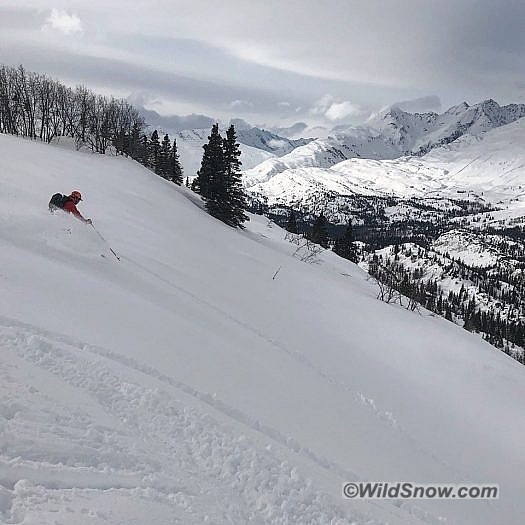
Tree skiing is rare in Valdez, but if the weather and snow doesn’t cooperate plenty of fun can still be had.
Okay, what’s the point of all this? Skiing is fun, but you already knew that. Alaska has exceptional skiing, but you already knew that too. My biggest lesson has been that skiing offers a unique perspective on community, place, and fun. The backcountry gave me a language for learning a new town, meeting people, and navigating my way in the mountains.
I’ll stay another year and see if the pattern repeats.
Dr. Alex Lee lives in Anchorage, Alaska. Alex is a professor at Alaska Pacific University, teaching philosophy and environmental studies. He also works as a sometimes guide, naturalist, writer, and photographer.

